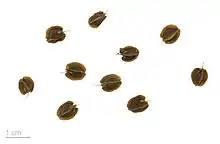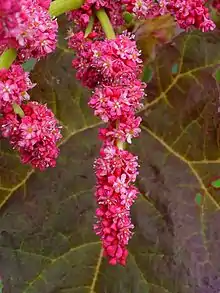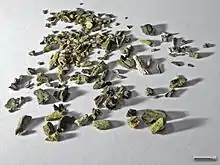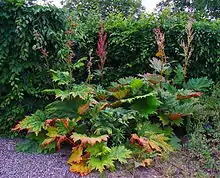Rheum palmatum
Rheum palmatum is a species of flowering plant in the knotweed family Polygonaceae. It is commonly called Chinese rhubarb,[1][2] ornamental rhubarb,[3] Turkey rhubarb[2] or East Indian rhubarb.[2]
| Turkey rhubarb | |
|---|---|
 | |
| Scientific classification | |
| Kingdom: | Plantae |
| Clade: | Tracheophytes |
| Clade: | Angiosperms |
| Clade: | Eudicots |
| Order: | Caryophyllales |
| Family: | Polygonaceae |
| Genus: | Rheum |
| Species: | R. palmatum |
| Binomial name | |
| Rheum palmatum | |

Rheum palmatum is a herbaceous perennial related to the edible rhubarb. It is primarily used in traditional medicine, and as an ornamental subject in the garden.
Taxonomy
Agnia Losina-Losinskaja proposed classifying it in the section Palmata in the Flora SSSR in 1936.[4] In the 1998 Flora Republicae popularis Sinicae A. R. Li maintains this classification for this species.[5]
Description


Its lobed leaves are large, jagged and hand-shaped, growing in width to two feet. Chinese rhubarb has thick, deep roots.[6]
Similar species
The species Rheum tanguticum is closely related to R. palmatum.[7]
R. palmatum can be distinguished from R. × hybridum, the garden rhubarb we eat, by size; while garden rhubarb only grows to a few feet in height, Chinese rhubarb can grow to six feet.[6]
Karyotypy
R. palmatum has a chromosome count of 2n=22.[5]
Distribution
It is native in the regions of western China, northern Tibet, and the Mongolian Plateau.[6]
Folk medicine

Rheum tanguticum, R. rhabarbarum and R. officinale and a few others, are all harvested for their roots, which are used as a herbal medicine.[7] This became one of the most prominent items traded along the Silk Road.[6] Imported roots of various rhubarb species were widely used in Europe for hundreds of years before the identity of the plant was eventually discovered.[6] Some of the common names associated with Rheum palmatum—"Russian rhubarb", "Turkey rhubarb", and "Indian rhubarb"—are directly affiliated with the trade routes for rhubarb from China.[6]
The root is known for its purported purging effects and suppressing fever.[6] In ancient China, rhubarb root was taken to try to cure stomach ailments and as a "cathartic" (an agent used to relieve constipation), and used as a poultice for "fevers and edema" (swelling caused by fluid retention in the body tissues).[6] It was given its Latin name by Carolus Linnaeus in the year 1759 and first grown in Britain around 1762.[6]
The first International Symposium on Rhubarb was held in China in 1990. Its objective was to verify the scientific data and treatment of Chinese Rhubarb used by Chinese pharmacopoeias.[6]
Health risks
Pregnant women should avoid all intake of the plant since it may cause uterine stimulation.[6] If taken for an extended amount of time, adverse effects include: "hypertrophy of the liver, thyroid, and stomach, as well as nausea, griping, abdominal pain, vomiting, and diarrhea."[6]
Though the root of the Chinese rhubarb is a key facet of herbal medicine, its leaves can actually be poisonous if consumed in large amounts due to the oxalic acid content.[6] Patients with "arthritis, kidney problems, inflammatory bowel disease, or intestinal obstruction" should refrain from consumption.[6]
Cultivation
Ornamental use

With its large palmate leaves and tall panicles of pink flowers, Rheum palmatum is a bold statement plant for the temperate garden, that grows up to 2.5 m (8.2 ft) tall and broad. It is hardy down to −20 °C (−4 °F).[8] It is propagated by seed in the spring, or by root division in spring or autumn.[7] It grows best in full sunlight in well-drained soil.[7]
The following cultivars have gained the Royal Horticultural Society’s Award of Garden Merit:-[9]
Farming as medicinal herb
Since it is the roots and rhizome which serve as this plant's source of medicinal usage, special care is taken in their preparation.[6] When 6–10 years old, the rhizomes of these plants are removed from the ground in the autumn when both its stems and leaves changed to yellow wild.[7] Furthermore, the removal of the lateral rootlets and the crown are removed, leaving only the root.[7] Any debris around the root is cleaned off, the coarse exterior bark removed, and the root cut and divided into cube-like pieces to increase its surface area, thereby decreasing the time needed for drying.[6]
References
- "Rheum palmatum". Natural Resources Conservation Service PLANTS Database. USDA. Retrieved 1 February 2016.
- Eisenreich, Dan (1996–2010). "Rhubarb Botanical Information". The Rhubarb Compendium. Retrieved 2011-02-07.
- "BSBI List 2007". Botanical Society of Britain and Ireland. Archived from the original (xls) on 2015-01-25. Retrieved 2014-10-17.
- Лозина-Лозинская, Агния Сергеевна (1936). "Rheum". In Комаро́в, Влади́мир Лео́нтьевич (ed.). Flora SSSR, Vol. 5 (in Russian). Moscow: Издателство Академии Наук СССР. pp. 500–501.
- Ruirui, Liu; Wang, Ailan; Tian, Xinmin; Wang, Dongshi; Liu, Jianquan (2010). "Uniformity of karyotypes in Rheum (Polygonaceae), a species-rich genus in the Qinghai-Tibetan Plateau and adjacent regions". Caryologia Firenze. 63 (1): 82–90. doi:10.1080/00087114.2010.10589711. S2CID 86616077. Retrieved 24 March 2019.
- Foster, Steven (2006). Desk Reference to Nature's Medicine. Washington, D.C.: National Geographic Society. pp. 104–105. ISBN 0-7922-3666-1.
- Chevallier, Andrew (2000). Natural Health: Encyclopedia of Herbal Medicine. New York, New York 10016: Dorling Kindersley. pp. 127. ISBN 0-7894-6783-6.CS1 maint: location (link)
- "RHS Plantfinder - Rheum palmatum". Retrieved 23 September 2018.
- "AGM Plants - Ornamental" (PDF). Royal Horticultural Society. July 2017. p. 84. Retrieved 27 September 2018.
- "RHS Plantfinder - Rheum 'Ace of Hearts'". Retrieved 23 September 2018.
- "RHS Plantfinder - Rheum palmatum 'Bowles's Crimson". Retrieved 23 September 2018.
- "RHS Plantfinder - Rheum palmatum 'Hadspen Crimson'". Retrieved 23 September 2018.